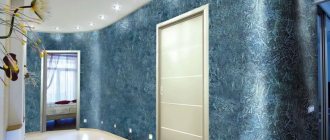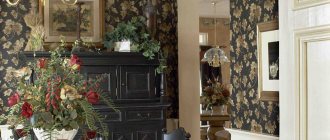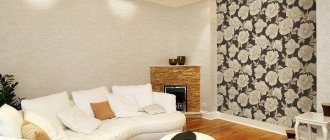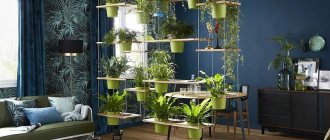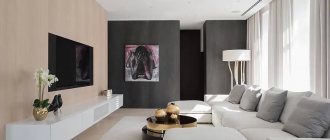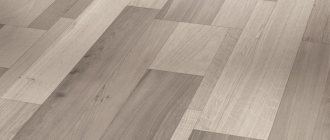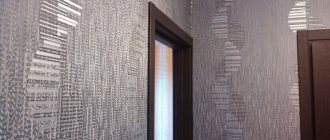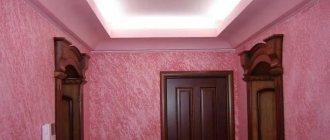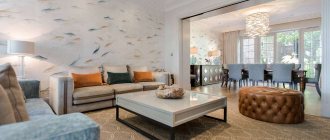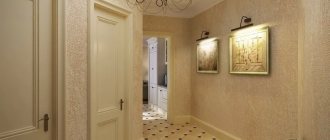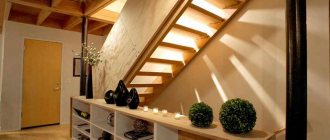Liquid wallpaper appeared relatively recently and has become a modern replacement for roll wallpaper. They are quite unusual, so not everyone understands their advantages and does not know where to use them. Meanwhile, using liquid wallpaper for walls in the interior, you can create a truly unusual design, intelligently combining colors and textures.
Example of use in the interior of a corridor Source dizain.guru
What it is
Liquid wallpaper is a material that is used for finishing wall and ceiling surfaces. They are more similar to plaster, but different in composition. They include cellulose fiber, silk, cotton, dry glue, antiseptics, as well as various decorative impurities.
Decorative impurities are quite varied. In fact, they create such wide variety. Glitters, silk fibers, velor, silk, beads and rhinestones, as well as various dyes are used as decoration.
Decor Source moyastena.ru
Color palette and structure Source kursremonta.ru
What substances are used for production?
To create this version of the finishing material, the following components are used:
- Adhesive base. This material is made in the form of a dry powder, which after contact with water increases in size and promotes adhesion of the decor to the concrete plane;
- Dyes. They allow you to paint the working composition in the required shade;
- Pulp of different sizes. For the production of liquid wallpaper, paper of different compositions and strengths is used. It is she who sets the texture and volume on the surface of the wall;
- Small fibers of silk threads. They provide the finished surface with shine and silky texture;
- Antiseptics and fungicides. These substances prevent the growth of bacteria and fungi on the surface;
- Decorative details in the form of mica, mother-of-pearl chips, sparkles of different diameters and mineral chips.
The material for decorating the interior space is sold in the form of a dry powder, which is pre-packaged in containers of different diameters. The shelf life of such finishing material is from 10 to 15 years.
Types of liquid wallpaper
They are divided into several types according to composition.
- Pulp.
Their main component is cellulose, that is, processed wood fibers. The coating is well suited to walls with slight unevenness; it can easily hide minor defects. In addition, this type is the most inexpensive and accessible.
The downside is that they are less aesthetically pleasing than silk ones. They also fade faster and cannot be used in rooms with high humidity.
Cellulose wallpaper in the interior Source top-1000.ru
- Silk.
The composition contains silk fibers instead of cellulose, which provides a greater degree of quality and aesthetics. They are less exposed to ultraviolet radiation, which makes them resistant to fading. More pleasant to the touch.
The disadvantages include the high cost, but it is justified - such liquid wallpaper in the room is the most wear-resistant and beautiful, they emphasize the status of the owner and create a unique style in the interior.
Example of silk wallpaper Source mykaleidoscope.ru
- Combined.
As the name implies, these wallpapers include both cellulose fiber and silk. This makes them higher quality than conventional cellulose wallpaper, but less expensive than silk.
Example of combined wallpaper Source mdr-s.ru
If we start not from the composition, but from the degree of readiness, then we can distinguish ready-to-use types of liquid wallpaper for walls or for painting.
- Ready to use.
Easy to use. The purchased composition only needs to be diluted with water according to the instructions, and you can glue it. This is the best option for those who are new to wall decoration.
- For painting.
They may have different structures and compositions, but only one color – white. You can paint them any way you like, and it is also possible to add decorative elements, but this is not possible for a non-professional.
An example of original painting of liquid wallpaper Source roomester.ru
Liquid wallpaper at home
How to make liquid wallpaper with your own hands? Today, the assortment of construction stores offers a huge number of finishing and consumable materials. However, many consumers prefer to create this type of decor at home. What will be needed to create a workforce? This list includes:
- Paper. To prepare the building composition, you can use absolutely any type of cellulose. The paper base is first crushed into small pieces;
- Next, we use color pigments, dry polyvinyl chloride, glitter, silk fibers and pearlescent powder;
- Mix all components thoroughly with each other. Then add water. The consistency should be similar to thick sour cream.
If the decorative base begins to peel off, then experts recommend adding more adhesive base. If cracks appear, filler must be replenished. The photo of liquid wallpaper shows the result of decorating a vertical coating.
Advantages and disadvantages
Of course, there are many advantages of liquid wallpaper over regular wallpaper, but it cannot be said that they are an ideal wall covering.
Advantages of liquid wallpaper:
- Safety – do not contain harmful components.
- Seamless – the absence of unaesthetic seams and the need to join the pattern.
- Long service life.
- Resistance to temperature changes.
- They have sound insulation quality.
- Maintainability - water will help you easily remove and replace the damaged area with a new mixture.
- Good coverage of walls with minor defects.
- Easily glued in hard-to-reach places.
- Easy removal.
- They don't collect dust.
High-quality installation Source top-1000.ru
Disadvantages:
- Low moisture resistance - cannot be used in rooms with high humidity.
- Dry clean only.
- High price.
- Long-term installation - dry for several days.
- Low mechanical strength - easily deteriorates under mechanical stress. This means that children can easily render them unusable through careless handling, and animals can scratch or chew them. But it won’t be difficult to replace a damaged area even just spot-on.
- The color range of liquid wallpaper for walls is more modest compared to roll wallpaper.
To increase the service life, it is necessary to follow the installation technology Source oooalfa-pro.ru
Application Features
To understand whether you can stick them on yourself, it is better to familiarize yourself with the technique of decorating walls with liquid wallpaper. The technique involves several steps:
- Surface preparation: cleaning the walls from the previous layer of wallpaper, grease stains, whitewash. Removing crumbling and uneven coating. Elimination of major defects.
- Applying the finishing coat.
- Applying wallpaper directly: according to the manufacturer's instructions, dilute with water and mix in the necessary decorative elements, leave the mixture for the time indicated on the package. Then it can be applied in several ways:
Application using a spatula Source kraski-net.ru
Using a roller Source sanmarco-vernici.ru
See also: Catalog of companies that specialize in finishing materials and related work
You can apply a thin layer of coating using a special compressor Source umcos.ru
Making your own mixture
Another drawback that can be corrected is the high cost of finishing. To reduce waste, you can prepare the solution yourself. To do this you need:
- finely chop or tear A-4 paper;
- Immerse the pieces in the container in which the solution will be prepared, fill them with water. There should not be too much liquid; it should cover the paper. The mixture is infused until the pieces become limp, approximately 2-3 hours;
- Grind the mixture with a construction mixer to obtain a homogeneous mass;
- add plaster, PVA glue, and dye to the same container. If desired, you can add decorations: glitter, shavings, etc. For 1 landscape sheet you need 1 teaspoon of plaster and 5 ml of glue;
- Apply the solution to the surface of the prepared wall with an iron spatula in a layer of 3-4 mm.
This “recipe” will cost you very little and will allow you to create a unique interior.
Floral pattern with liquid wallpaper
Rose drawing with liquid wallpaper
Caring for wallpaper is easy. Cleaning should be dry, avoid any contact with a damp sponge or brush. If the area is very dirty, it can be removed and a new layer of a similar mixture and shade applied. This must be done carefully using a sharp knife or spatula. After application, the area will be slightly different from the main wall, but after complete drying the color will be equal.
Fish drawing with liquid wallpaper
Drawing on blue liquid wallpaper
There are many options for sketches of drawings for creating an exclusive room design. Warm colors can give the room additional comfort and coziness. Cold ones will visually increase the space.
Finishing material will help create unique scenes in your home and office. Choose a design that suits you, experiment with shades and enjoy your own masterpieces.
Mixing liquid wallpaper on the wall
Where appropriate to use
They are suitable for rooms with low humidity. Should not be used in the bathroom or kitchen work area. Well suited for decorating a living room, bedroom, corridor. Can be used in a children's room, as the material is completely safe.
But it is worth remembering that such a coating easily deteriorates under mechanical stress. Therefore, it is better to think carefully about the placement if there are animals in the house that like to chew or scratch the walls.
Liquid wallpaper can be combined with other coatings and applied to part of the wall. The use of liquid wallpaper in the interior will be discussed below.
Tools
To apply liquid wallpaper you will need to prepare a special and familiar tool. They will be a spatula and a trowel for leveling the surface, a container for diluting the mass, and a measuring cup for water.
The thin mixture can be applied with rollers; for finishing large and very large rooms you will need a cartouche gun and a compressor for it.
Living room
Liquid wallpaper is great for decorating a living room. Thanks to the soft and pleasant-to-touch surface, liquid wallpaper in the living room interior creates an atmosphere of comfort. Silk or combined ones look especially good - they create the impression of soft textiles on the walls.
An example of using silk wallpaper in the living room Source domdom.com.ua
It is not necessary to cover the entire surface. Sometimes it is enough to select only one wall.
For the living room, the best option to emphasize the unusualness of the interior is to decorate the wall opposite the sofa Source design-homes.ru
An even more economical option is to allocate one zone.
Beautiful combination Source andromeda1.rf
For those who want a more original design, decorative inserts have been invented. As a rule, they can be ordered individually. In addition, the drawing will add unusualness to the room.
Additional decor Source sense-life.com
Interesting performance Source basketgoods.ru
Cozy living room Source prom.st
Bedroom
Once you stick liquid wallpaper in your bedroom, its design will change significantly. The bedroom is the best place to use them. It is this room that needs comfort and softness, where you really want to relax.
Example of use in the bedroom Source spp-group.ru
If you focus on one wall, then the one where the head of the bed is located is best.
To focus on individual zones, you can adhere to this rule, but it is not necessary Source mebel-go.ru
A bright bedroom is not the best choice for everyone. If both spouses insist on different colors, liquid wallpaper in the room can be combined.
Sometimes a bedroom in dark colors looks very atmospheric Source lumetri.ru
Dark tones and sparkles add unusualness and piquancy to the room Source free-lancers.net
Hallway and corridor
Perhaps the most important rule when decorating these rooms is compatibility with the rest of the living rooms.
Good combination with other coatings Source homeli.ru
Often the hallway and corridor are not very lit, so it is better to choose lighter shades.
If you coat the surface with varnish, it can be washed. Source dizainexpert.ru
Golden colors add luxury. But they should be used sparingly Source lustora.ru
Liquid wallpaper goes well with regular wallpaper Source vipremonti.ru
Kitchen
Although liquid wallpaper is not recommended for use in the kitchen, some still decide to do it. In this case, it is better not to use them in the work area or near water.
Some are ready to disregard the rule. It turns out great Source vseo-remonte.ru
If you coat the surface with varnish, it can be washed Source valles.top
You can always decorate the dining area Source dizainexpert.ru
Security measures
Before you proudly declare: “Today we apply liquid wallpaper ourselves,” you should take care of the safety of future work and nearby objects.
The wiring must be de-energized. It is better to seal sockets, switches, window and door frames with masking tape, and cover the floor and furniture with film. If the repairmen are confident in their accuracy, this point can be skipped, especially since the mass retains its plasticity for a long time and is easily washed off with water.
Briefly about the main thing
Liquid wallpaper is an excellent solution for living rooms that you want to add originality and comfort. They are easy to glue and repair, and you can use them to create any design. But you shouldn’t glue them in rooms with high humidity, although it all depends on how liquid wallpaper is used in living rooms.
They will fit perfectly into living spaces, making them softer and more atmospheric. They can be used both on the entire surface and on a separate wall. Can be combined with other coatings. The highlight can be a pattern or sparkles.
Wallpaper is good for a child's room, where you can use it to draw anything. You can add textiles, beads, sparkles and fluorescent to the composition.
It is not advisable to use them in the kitchen, but if desired, the wallpaper can be varnished, this will increase its moisture resistance.
Preparation of the composition
Liquid wallpaper is sold in stores in dry form. Water is poured into the mixture in advance and everything is thoroughly mixed. The exact proportions are always indicated by the manufacturer in the instructions.
The finished mass is most often poured back into a thick plastic bag and allowed to brew for 8-10 hours for full swelling.
Attention! You must understand that the dried coating will be much lighter than the wet one. This feature should be taken into account when adding coloring pigments to the solution.
